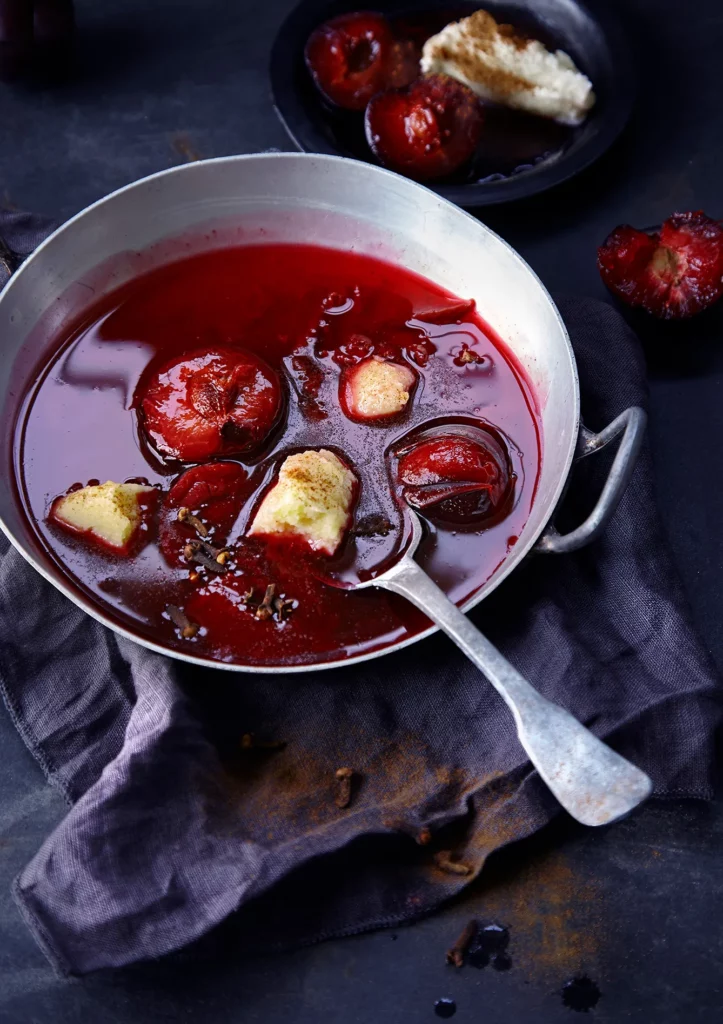And we think you could consider yourself an iron-stomached person to jump in the deep end and eat some of them when coming from a drastically different background of eating habits. Not that they are not tasty – the soups exist to this day because they have many enthusiasts among Polish people. It’s the ingredients that give some people the jitters. And what can Poles stir in one pot?
Fruit Soup
Let’s start with the least shocking proposition: fruit soup. What can possibly go wrong? But what if we told you this is not any gazpacho-stye, cold fruity punch but rather a dish that is meant to constitute the first course of a meal? Meaning – served warm. With noodles. Or batter dumplings? Often prepared from preserves such as compotes, fruit soups usually contain cherries and plums, but it is not uncommon to see their apple versions.
There are even some traditionally recognized takes on a fruit soup, like the 19th-century pear soup (grusconka), extremely popular in the Łowicz area, or the traditional Polish version known as garus. This soup, made from pears and sweet apples (with the addition of plums from time to time), could be served with grilled pear, but more often, it was presented with… potatoes and fried onion or bacon. Yummy…?
Botwinka
This typically spring soup is a delicacy which, for some inexplicable reasons, raises eyebrows among foreigners who happen to be offered this dish. Perhaps they cannot initially believe that a bunch of young beetroot leaves chucked into a pot can turn into something palatable. Oh, those who did not try to make a chard soup have no idea what they are missing!



This delicate soup is plenty of good vitamins and minerals. Simple preparation is an additional bonus. Traditionally the base for the soup would be a vegetable broth (on rare occasions – its meaty version) in which the chard was cooked together with some young beetroots until tender. Then the soup was thickened with flour, dressed with cream, and served with potatoes, spring onion, fried onions, and bacon.
Sometimes (like in my home), we throw in a boiled egg. There is something about the freshness of the soup which lures many Poles to the markets in the spring precisely for some chard necessary to make their favorite, simple, vitamin-rich soup. Fun fact – as the idea for the soup was borrowed many centuries ago from the lands of today’s Belarus, the Polish word for chard (botwina) was not what gave the soup its name. It was entirely the other way round – chard was named after the soup prepared from young beetroots and is etymologically rooted in old Belarusan.
Flaki
We are now entering more controversial lands of soups prepared from stuff most people throw into the bin. Not in the past, however, when every part of the animal killed had its purpose. Leaving the zero-waste philosophy aside, still today, many Poles will feel their mouths watering at the idea of feasting on a warm bowl of flaki. If we were cruel, we would translate this literally and start a story about the Polish guts soup, but we shall not do that. This would be too much. Albeit, the main ingredient of the soup is in its name, and it is, in fact, a carefully washed cow’s stomach (sometimes pig’s or venison – such as deer or moose, but, frankly, living in Poland for decades, I have never seen such a posh version available).
The soup is thick and heavily spiced. Its different versions are present in other Central European countries (such as Austria and Czechia), as well as in other countries of the world. In Poland, the soup was consumed as early as the 14th century and, apparently, was loved by King Casimir the Great and was the favorite dish of King Jogaila (Jagełło) and his spouse, King-Queen Jadwiga. These days, flaki is still popular, and many Pole will eagerly eat a well-prepared bowl of this soup which is said to be filling and warming.
Czernina
Now, this soup is downright twofold cruel. Firstly, it was traditionally served to a young man as a rejection of his offer of marriage (it is czernina that features in Pan Tadeusz under the description of a black soup served to Jacek Soplica). It is also cruel as its name cleverly disguises the main ingredient used for its preparation. No wonder. It is doubtful that there would be many amateurs of a bowl of blood soup unless they were the mythical dwellers of Transylvania.
But yes – czernina is described as sweet and acidic in flavor and rather thick in consistency. It’s made from pig’s, duck’s, or goose’s blood and served with giblets, pieces of meat, and dumplings. The oldest recipe for this typically Polish soup can be found in the first Polish cookbook, the Compendium Ferculorum (published in the 17th century). In 2023 czernina was announced as the world’s worst soup, according to the TasteAtlas internet portal. Harsh. Maybe the cook was simply incredibly bad? Dare sample?
Żurek
It would be unfair to end with the world’s worst soup when Poland can proudly say the same year, its own żurek was announced as the second world’s best soup! Both thanks to its flavor but also its nutritional value. Żurek is based on fermented rye flour and has been known in Poland since the 15th century. This rather unobvious foundation for the undeniable, slightly acidic delicacy has its reflection in a legend of how the soup was invented.
It speaks of a stingy baker and innkeeper who lived in the area of Poznań. He was infamously known for selling drinks thinned with water and serving foul-tasting food. One day, his neighbors, sick of the cons, paid a man to bet with the innkeeper for a sack of golden coins that he would eat the worst soup the innkeeper prepared. The bet seemed simple enough. The innkeeper grabbed some sourdough, added hot water and anything he could find that was within his reach – veg, sausage, mushrooms – and seasoned it with garlic and marjoram.
The innkeeper was sure such a combination would be inedible, but to this surprise, the man finished his meal and said it was one of the tastiest soups he had ever had. Other guests also wanted to try it and confirmed the soup was delicious. The innkeeper lost his bet, as well as a large fortune, and is said to have moved o Silesia. The innkeeper might have left the community, but the soup stayed and became one of the treasures of the national cuisine. Give it a try – you won’t regret it!







